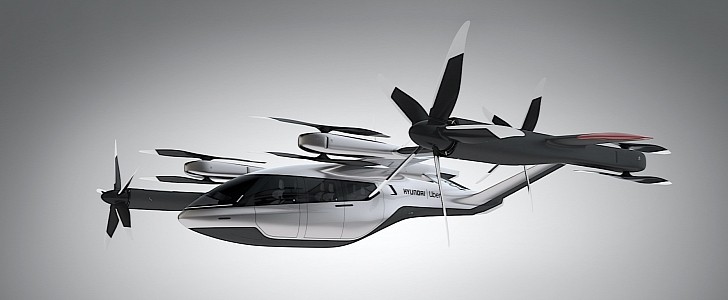The likes of Hyundai and General Motors are set on developing flying cars with the South Korean brand feeling optimistic that it could have an air taxi service up and running within the next four years. A General Motors exec meanwhile believes 2030 is a more realistic target, as air taxi services first need to overcome several technical and regulatory hurdles.
These so-called “flying cars” are being developed not just by Hyundai and GM, but quite a few startups, plus aircraft manufacturers and other carmakers. The goal is to have these aircraft take off and land vertically, just like helicopters, carrying both passengers and cargo.
During an interview at the Reuters Events Car of the Future conference, Hyundai COO Jose Munoz said that his company is already ahead of its previously stated timetable for the roll out of air-mobility vehicles.
Munoz is also CEO of Hyundai North America and while he previously told the media that urban air taxis could be operational at major U.S. airports by 2028, he now believes that it could happen a lot sooner, even before 2025.
“We see this market as a significant growth opportunity,” he said, adding that he’s “very confident” of the technology’s development.
Now, don’t think you’re about to see a flying Tucson anytime soon, because the air taxis that Hyundai is developing will feature a functional design and will be able to transport five to six people using electric battery power – see the S-A1 PAV concept unveiled during the 2020 Consumer Electronics Show in Las Vegas.
Other carmakers developing “flying cars” include Toyota, Daimler, Geely and of course GM, who earlier this year unveiled a so-called eVTOL (electric vertical take-off and landing) aircraft, using Cadillac branding.
Going forward, this new industry could be looking at a very bright future, at least that’s what Morgan Stanley believes. The investment banking firm is estimating that the total addressable market for urban air mobility could hit the $1 trillion mark by 2040 and $9 trillion by 2050.
During an interview at the Reuters Events Car of the Future conference, Hyundai COO Jose Munoz said that his company is already ahead of its previously stated timetable for the roll out of air-mobility vehicles.
Munoz is also CEO of Hyundai North America and while he previously told the media that urban air taxis could be operational at major U.S. airports by 2028, he now believes that it could happen a lot sooner, even before 2025.
“We see this market as a significant growth opportunity,” he said, adding that he’s “very confident” of the technology’s development.
Now, don’t think you’re about to see a flying Tucson anytime soon, because the air taxis that Hyundai is developing will feature a functional design and will be able to transport five to six people using electric battery power – see the S-A1 PAV concept unveiled during the 2020 Consumer Electronics Show in Las Vegas.
Other carmakers developing “flying cars” include Toyota, Daimler, Geely and of course GM, who earlier this year unveiled a so-called eVTOL (electric vertical take-off and landing) aircraft, using Cadillac branding.
Going forward, this new industry could be looking at a very bright future, at least that’s what Morgan Stanley believes. The investment banking firm is estimating that the total addressable market for urban air mobility could hit the $1 trillion mark by 2040 and $9 trillion by 2050.








